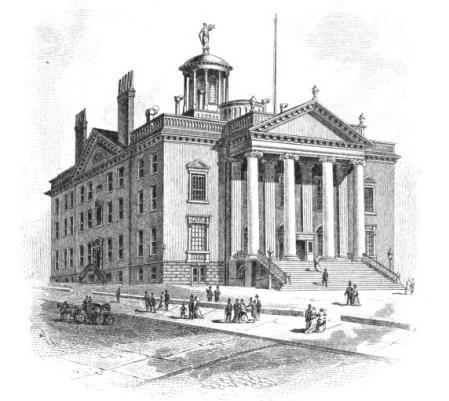Members 32 Members 126 | Party control Bucktail | |
 | ||
Term July 1, 1819 – June 30, 1820 President Lt. Gov. John Tayler (Dem.-Rep.) | ||
The 43rd New York State Legislature, consisting of the New York State Senate and the New York State Assembly, met from January 4 to April 14, 1820, during the third year of DeWitt Clinton's governorship, in Albany.
Contents
Background
Under the provisions of the New York Constitution of 1777, amended by the Constitutional Convention of 1801, 32 Senators were elected on general tickets in the four senatorial districts for four-year terms. They were divided into four classes, and every year eight Senate seats came up for election. Assemblymen were elected countywide on general tickets to a one-year term, the whole Assembly being renewed annually.
In 1797, Albany was declared the State capital, and all subsequent Legislatures have met there since. In 1818, the Legislature enacted that future Legislatures meet on the first Tuesday of January of each year unless called earlier by the governor.
State Senator Darius Crosby died on November 18, 1818, leaving a vacancy in the Southern District.
At this time the politicians were divided into two opposing political parties: the Federalists and the Democratic-Republicans. The Democratic-Republican Party was split into two factions: the Clintonians (supporters of Gov. DeWitt Clinton) and the Bucktails (led by Martin Van Buren, and including the Tammany Hall organization in New York City).
Elections
The State election was held from April 27 to 29, 1819. The Federalists ran their own tickets in counties where they had a majority, but endorsed and supported the Clintonians in most places where they were a minority.
Senator Peter R. Livingston (Southern D.) was re-elected. Charles E. Dudley, John T. More (both Middle D.), Benjamin Mooers, Thomas Frothingham (both Eastern D.), Gideon Granger, Lyman Paine (both Western D.), and Assemblyman Duncan McMartin Jr. (Eastern D.) were also elected to full terms in the Senate. John Townsend (Southern D.) was elected to fill the vacancy. Livingston, Dudley, More and Townsend were Bucktails, the other five Clintonians.
Sessions
The Legislature met at the Old State Capitol in Albany on January 4, 1820, and adjourned on April 14.
John C. Spencer (Clint.) was elected Speaker by a combined Clintonian/Federalist majority with 64 votes against 50 for Peter Sharpe (Buckt.). Aaron Clark (Dem.-Rep.) was re-elected Clerk of the Assembly with 87 votes against 32 for James Van Ingen (Fed.).
After resolutions for the call of a Constitutional convention had been rejected during the two previous sessions, Gov. DeWitt Clinton now recommended to call a convention with limited powers to amend the State Constitution. This convention should have the power to abolish the Council of Appointment, and consider such other amendments as designated by the Legislature. The Bucktails wanted a Convention with unlimited powers, and nothing came of it at this session either. The issue was pursued further by the Bucktails at the next session, and led to the New York State Constitutional Convention of 1821, and a new Constitution.
On January 8, the Legislature re-elected unanimously Rufus King (Fed.) as U.S. Senator from New York, to fill the vacancy caused by the failure to elect a successor during the previous session.
On January 18, a caucus of 64 Bucktail legislators nominated U.S. Vice President Daniel D. Tompkins for Governor and State Senator Benjamin Mooers for Lieutenant Governor.
Districts
Members
The asterisk (*) denotes members of the previous Legislature who continued in office as members of this Legislature. Duncan McMartin Jr. changed from the Assembly to the Senate.
Employees
Assemblymen
The asterisk (*) denotes members of the previous Legislature who continued as members of this Legislature. Henry Seymour changed from the Senate to the Assembly.
